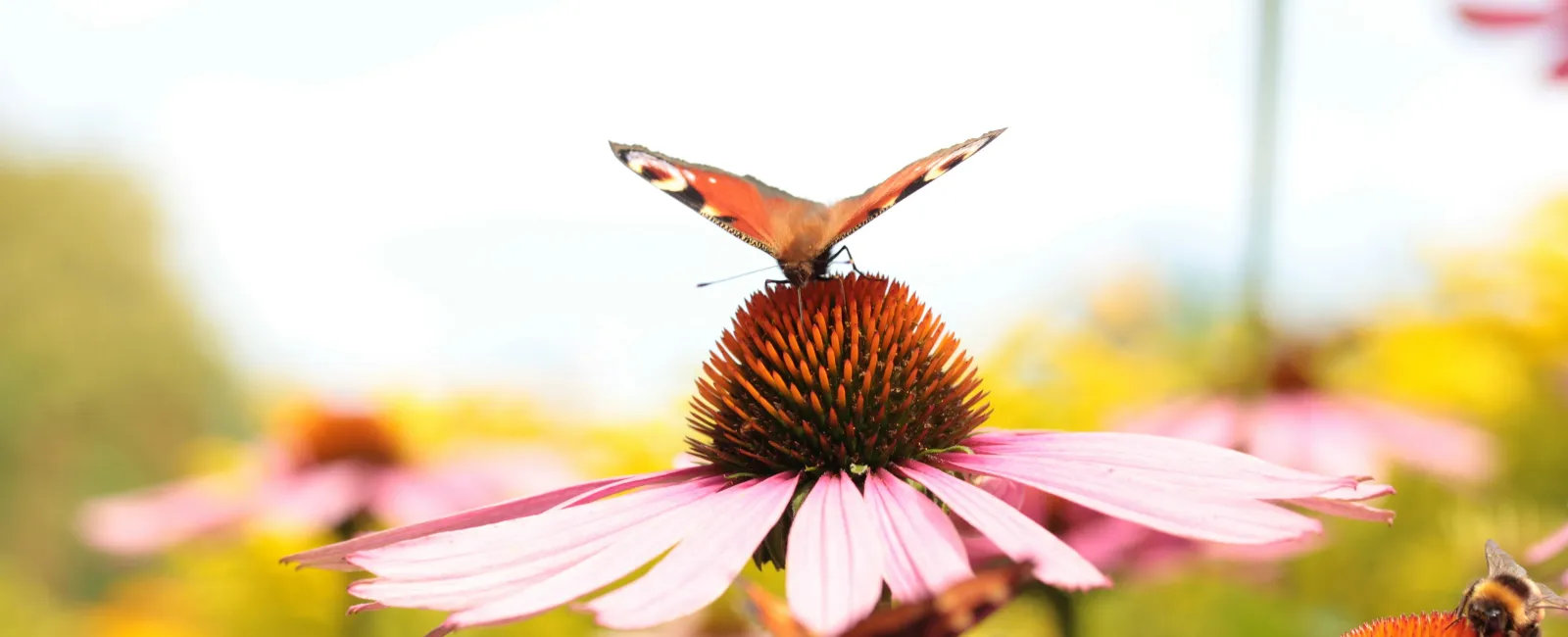Coneflowers (Echinacea) thrive in full sun, requiring at least 6-8 hours of direct sunlight daily. They are easy to grow, drought-tolerant, and come back yearly, making them a reliable perennial for most gardens. To care for coneflowers, regularly plant them in well-drained soil and water in their first season and use deadhead spent blooms to encourage more flowers. Cut back the stems in late fall for winter prep, and expect them to spread naturally through self-seeding. These hardy plants attract pollinators and are low-maintenance once established.
Do Coneflowers Like Sun or Shade?
Coneflowers thrive in full sun—they need at least 6 to 8 hours of direct sunlight daily to shine. While they can tolerate partial shade, they may not bloom as heavily, and their growth can become slightly leggy. If you want the most blooms and the healthiest plants, choose a sunny spot in your garden.
How to Plant Coneflowers
Planting coneflowers is straightforward and doesn't require any special tricks. Here's what to do:
Pick a Sunny Location: Choose a spot with plenty of sunlight and well-drained soil.
Prepare the Soil: While coneflowers aren't fussy about soil, they do best in rich, well-draining soil. If needed, loosen the soil and mix in some compost to start the plants well.
Planting the Coneflower: Dig a hole about twice the size of the plant's root ball, place the plant in the hole, and fill it back in with soil. Be sure to water it well after planting.
Spacing: Give each plant about 1 to 2 feet of space. Coneflowers can spread over time, so leaving enough room for them to grow is good.
What Happens After Planting?
When you first plant coneflowers, they may take a little time to settle in. During the first season, they're mainly focused on establishing their roots, so you might not see a ton of growth right away. By the second year, you should see more flowers and fuller plants.
One of the best things about coneflowers is that they're perennials, meaning they come back yearly. Once established, you can count on them to provide a reliable splash of color from mid-summer to fall.
Do Coneflowers Spread Easily?
Yes, coneflowers can spread quickly, which can be good or bad depending on your goals. They naturally self-seed, meaning the flower seeds can fall and grow into new plants the following year. This is a bonus if you hope to fill out a garden space. But if you want to control their spread, deadheading (removing spent blooms) is a simple solution.
Cutting off the dead flowers prevents them from dropping seeds and encourages the plant to produce even more blooms. If you're okay with a little natural spread, leave a few flower heads intact, and they'll do the work of reseeding for you.
Should I Cut Back Coneflowers for Winter?
Coneflowers are tough plants that can handle winter without much help, but cutting them back in late fall can help tidy up your garden and promote healthier plants for the following season.
Here's what to do:
Trim in Late Fall: Once the plant is done blooming and the leaves and stems start turning brown, cut the plant down to about 6 to 8 inches above the ground. This helps keep your garden neat and reduces the risk of pests or diseases overwintering in the dead plant matter.
Leave Some Flower Heads: If you enjoy watching birds in your garden, consider leaving a few seed heads intact. Birds like finches will feast on the seeds throughout the winter, adding a bit of life to your garden when everything else is quiet.
Mulching: In colder regions, adding a layer of mulch around the base of the plant can protect the roots from freezing temperatures. It's not always necessary, but it can help.
Watering and Fertilizing Coneflowers
One of the great things about coneflowers is how low-maintenance they are once established.
Watering: Moisturize the soil during the first year to help the plant establish its root system. After that, coneflowers become pretty drought-tolerant. Water them deeply once a week during dry spells, but they don't need much fuss.
Fertilizing: Coneflowers don't require heavy feeding, but too much fertilizer can lead to fewer blooms. A light application of compost in the spring or a balanced, slow-release fertilizer should be more than enough. They'll thrive without any extra fertilizing at all.
Deadheading Coneflowers: Do You Need to?
Deadheading is optional with coneflowers but can be beneficial depending on wyou'reu're hoping to achieve.
Deadheading is good if you want more blooms throughout the growing season. You encourage the plant to keep producing new flowers by cutting off spent flowers. You can keep some flower heads inside if you're okay with self-seeding and don't mind a little natural spread. They'll dry out, and the seeds will naturally disperse, potentially giving you new plants in the following seasons.
Do Coneflowers Come Back Every Year?
Yes! One of the most significant advantages of coneflowers is that they are perennials. Once you plant, they'll return yearly, often getting more critical and producing more flowers each time. You can enjoy their blooms for many seasons with just a little care.
Coneflowers in Garden Design
Coneflowers are versatile plants that work well in a variety of garden settings. Here are a few ideas:
Pollinator Gardens: Coneflowers attract butterflies, bees, and other pollinators, making them an excellent choice for a garden designed to support local wildlife. Pair them with milkweed, bee balm, and black-eyed Susans for a pollinator-friendly space.
Cottage Gardens: With their slightly wild, natural look, coneflowers fit beautifully into a cottage-style garden. Combine them with plants like lavender, daisies, and hollyhocks to create a relaxed, colorful display.
Borders and Beds: Thanks to their height (usually 2 to 4 feet), coneflowers make a great middle or back border plant in garden beds. Surround them with shorter perennials or grasses for a layered effect.
Meadow Gardens: Coneflowers are native to prairies, so they're a natural fit for meadows or wildflower gardens. Mix them with other native plants and grasses like little bluestem or switchgrass for a low-maintenance, natural look.
Final Thoughts
Coneflowers are one of the easiest and most rewarding perennials you can grow. They don't require much special care, are drought-tolerant once established, and provide months of colorful blooms. Whether you want to create a vibrant border, attract pollinators, or fill out a meadow garden, coneflowers are perfect. You can enjoy these hardy plants for many years with attention to planting, watering, and occasional deadheading.





